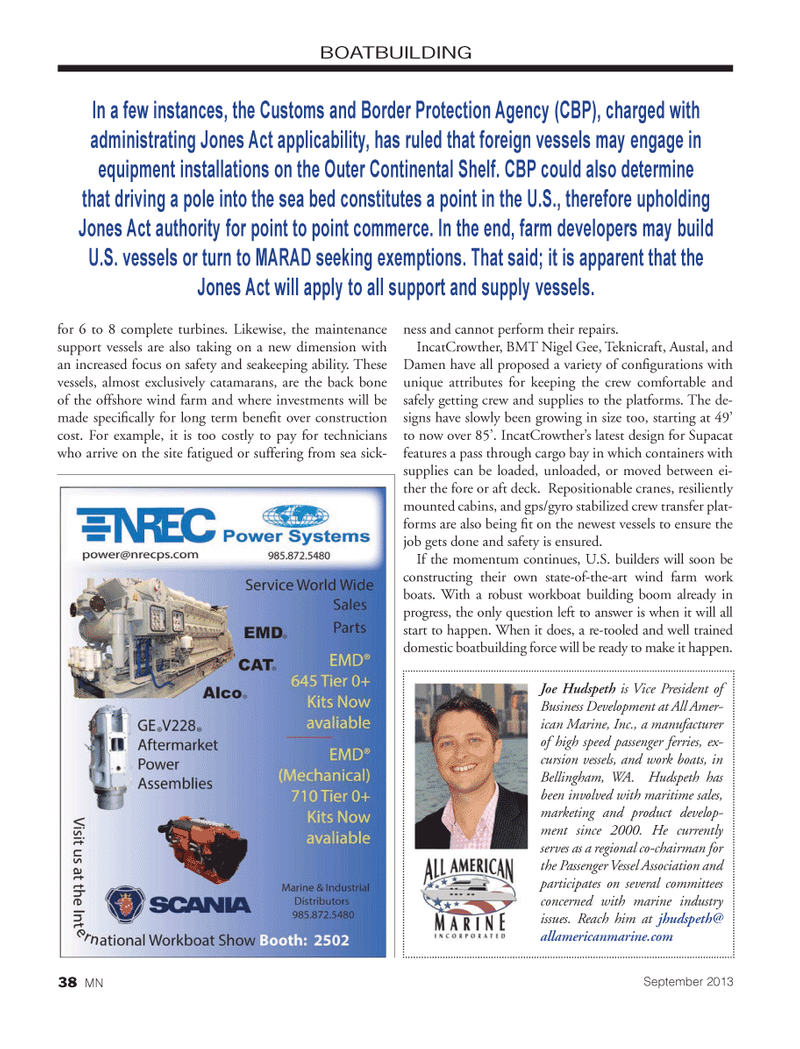
Page 38: of Marine News Magazine (September 2013)
Workboat Annual
Read this page in Pdf, Flash or Html5 edition of September 2013 Marine News Magazine
for 6 to 8 complete turbines. Likewise, the maintenance support vessels are also taking on a new dimension with an increased focus on safety and seakeeping ability. These vessels, almost exclusively catamarans, are the back bone of the offshore wind farm and where investments will be made speci? cally for long term bene? t over construction cost. For example, it is too costly to pay for technicians who arrive on the site fatigued or suffering from sea sick- ness and cannot perform their repairs. IncatCrowther, BMT Nigel Gee, Teknicraft, Austal, and Damen have all proposed a variety of con? gurations with unique attributes for keeping the crew comfortable and safely getting crew and supplies to the platforms. The de- signs have slowly been growing in size too, starting at 49 to now over 85. IncatCrowthers latest design for Supacat features a pass through cargo bay in which containers with supplies can be loaded, unloaded, or moved between ei- ther the fore or aft deck. Repositionable cranes, resiliently mounted cabins, and gps/gyro stabilized crew transfer plat- forms are also being ? t on the newest vessels to ensure the job gets done and safety is ensured. If the momentum continues, U.S. builders will soon be constructing their own state-of-the-art wind farm work boats. With a robust workboat building boom already in progress, the only question left to answer is when it will all start to happen. When it does, a re-tooled and well trained domestic boatbuilding force will be ready to make it happen. BOATBUILDING Joe Hudspeth is Vice President of Business Development at All Amer- ican Marine, Inc., a manufacturer of high speed passenger ferries, ex-cursion vessels, and work boats, in Bellingham, WA. Hudspeth has been involved with maritime sales, marketing and product develop- ment since 2000. He currently serves as a regional co-chairman for the Passenger Vessel Association and participates on several committees concerned with marine industry issues. Reach him at [email protected] a few instances, the Customs and Border Protection Agency (CBP), charged with administrating Jones Act applicability, has ruled that foreign vessels may engage in equipment installations on the Outer Continental Shelf. CBP could also determine that driving a pole into the sea bed constitutes a point in the U.S., therefore upholding Jones Act authority for point to point commerce. In the end, farm developers may build U.S. vessels or turn to MARAD seeking exemptions. That said; it is apparent that the Jones Act will apply to all support and supply vessels. September 201338 MNMN Sept2013 Layout 32-49.indd 388/29/2013 5:26:47 PM

 37
37

 39
39
